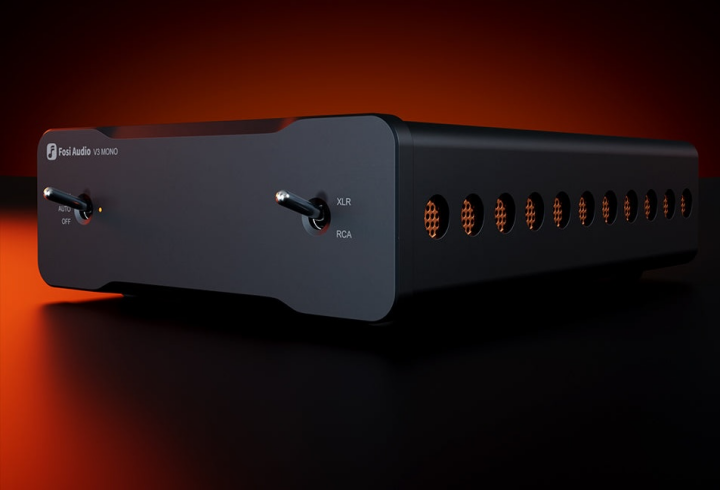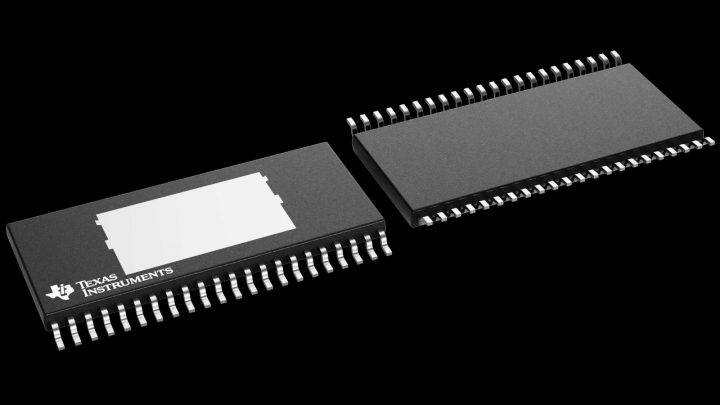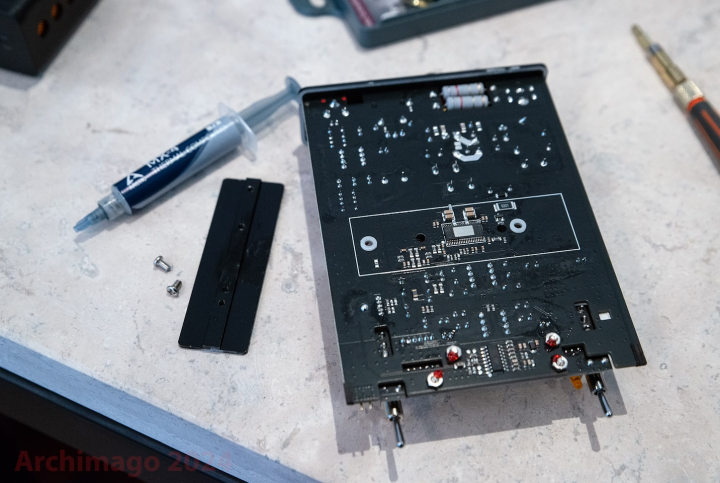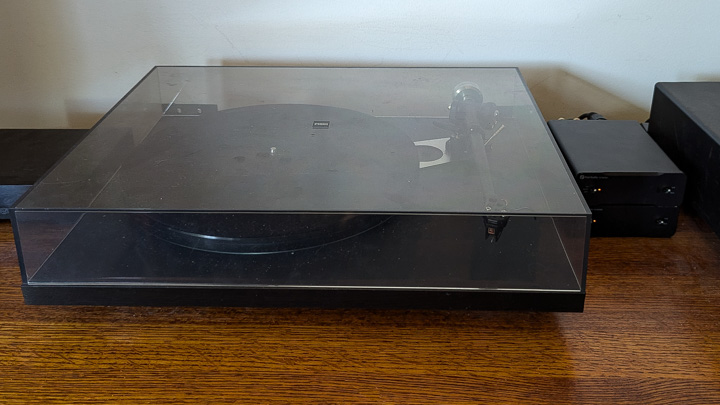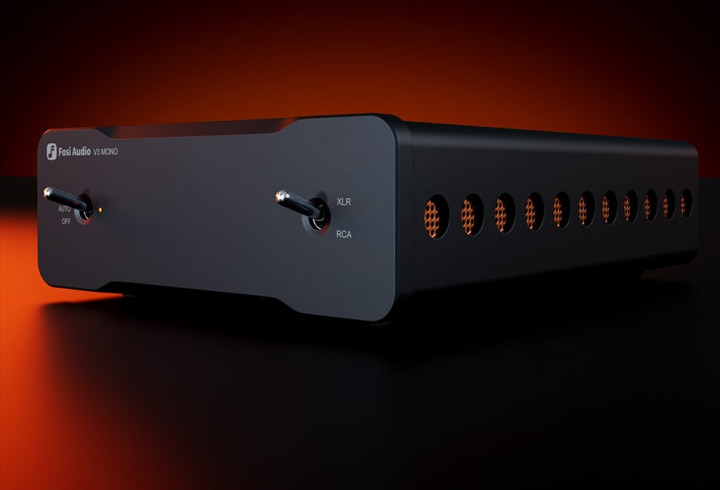
The less interesting part of the story is that my big home stereo has new amplification: Tiny Class-D Monoblocks! (Terminology explained below.) More interesting, another audiophile tenet has been holed below the waterline by Moore’s Law. This is a good thing, both for people who just want good sound to be cheaper, and for deranged audiophiles like me.
Tl;dr · This was going to be a short piece, but it got out of control. So, here’s the deal: Audiophiles who love good sound and are willing to throw money at the problem should now throw almost all of it at the pure-analog pieces:
Speakers.
Listening room setup.
Phono cartridge (and maybe turntable) (if you do LPs).
What’s new and different is that amplification technology has joined D-to-A conversion as a domain where small, cheap, semiconductors offer performance that’s close enough to perfect to not matter. The rest of this piece is an overly-long discussion of what amplification is and of the new technology.
The future of amplifiers looks something like this; more below.
What’s an “amp”? · A stereo system can have lots of pieces: Record players, cartridges, DACs, volume and tone controls, input selectors, and speakers. But in every system the last step before the speakers is the “power amplifier”; let’s just say “amp”. Upstream, music is routed round the system, not with electrical currents, but by a voltage signal, we say “line level”. That is to say, the voltage vibrates back and forth, usually between +/-1V, the vibration pattern being that of the music, i.e. that of the sound-wave vibrations you want the speakers to produce in the air between them and your ears.
Now, it takes a lot more than +/-1V to make sound come out of speakers. You need actual electrical current and multiple watts of energy to vibrate the electromagnets in your speakers and generate sound by pushing air around, which will push your eardrums around, which sends data to your brain that results in the experience of pleasure. If you have a big room and not-terribly-efficient speakers and are trying to play a Mahler symphony really loud, it can get into hundreds of watts.
So what an amp does take the line-level voltage signal and turn it into a corresponding electric-current signal with enough oomph behind it to emulate the hundred or so musicians required for that Mahler.
Some speakers (subwoofers, sound bars) come with amps built in, so you just have to send them the line-level signal and they take care of the rest. But in a serious audiophile system, your speakers are typically passive unpowered devices driven through speaker wires by an amp.
Historically, high-end amps have often been large, heavy, expensive, impressive-looking devices. The power can come either from vacuum tubes or “solid-state” circuits (basically, transistors and capacitors). Vacuum tubes are old technology and prone to distortion when driven too hard; electric-guitar amps do this deliberately to produce cool snarly sounds. But there are audiophiles who love tube amps and plenty are sold.
Amps come in pairs, one for each speaker, usually together in a box called a “stereo amplifier”. Sometimes the box also has volume and tone controls and so on, in which case it’s called an “integrated amplifier”.
So, what’s new?
TPA3255 · This thing, made by Texas Instruments, is described as a “315-W stereo, 600-W mono, 18 to 53.5V supply, analog input Class-D audio amplifier”. It’s tiny: 14x6.1mm! It sort of blows my mind that this little sliver of semiconductor can serve as the engine for the class of amps that used to weigh 20kg and be the size of a small suitcase. Also that it can deliver hundreds of watts of power without vanishing in a puff of smoke.
Also, it costs less than $20, quantity one.
It’s not that new, was released in 2016. It would be wrong to have expected products built around it to arrive right away. I said above that the chip is the engine of an amplifier, and just like a car, once you have an engine there’s still lots to be built. You have to route the signal and power to the chip — and this particular chip needs a lot of power. You have to route the chip output to the speaker connection, and you have to deal with the fact that speakers’ impedences (impedance is resistance, except for alternating rather than direct current) vary with audio frequency in complicated ways.
Anyhow, to make a long story short, in the last couple of years there have started to be TPA3255-based amps that are aimed at audiophiles, claiming a combination of high power, high accuracy, small size, and low price. And technically-sophisticated reviewers have started to do serious measurements on them and… wow. The results seem to show that the power is as advertised, and that any distortion or nonlinearity is way down below the sensitivity of human hearing. Which is to say, more or less perfect.
For example, check out the work of Archimago, an extremely technical high-end audio blogger, who’s been digging in deep on TPA3255-based amps. If you want to look at a lot of graphs most of which will be incomprehensible unless you’ve got a university education in the subject, check out his reviews of the AIYIMA A08 Pro, Fosi Audio TB10D, and Aoshida A7.
Or, actually, don’t. Below I’ll link to the measurements of the one I bought, and discuss why it’s especially interesting. (Well, maybe do have a quick look, because some of these little beasties come with a charming steampunk aesthetic.)
PWM · That stands for pulse-width modulation, the technique that makes Class-D amps work. It’s remarkably clever. You have the line-level audio input, and you also bring in a triangle-wave signal (straight lines up then back down) at a higher frequency, and you take samples at another higher frequency and if the audio voltage is higher than the sawtooth voltage, you turn the power on, and if lower, you turn it off. So the effect is that the louder the music, the higher the proportion of time the power is on. So you get current output that is shaped like the voltage input, only with lots of little square corners that look like high-frequency noise; an appropriate circuit filters out the high frequencies and reproduces the shape of the input wave with high accuracy.
If that didn’t make sense, here’s a decent YouTube explainer.
The explanation, which my understanding of practical electronics doesn’t go deep enough to validate, is that because the power is only ever on or off, no intermediate states are necessary and the circuit is super efficient therefore cheap.
Monoblocks · Most amps are “stereo amplifiers”, i.e. two amps in a box. They have to solve the problem of keeping the two stereo signals from affecting each other. It turns out the TPA3255 does this right on the chip. So the people who measure and evaluate these devices pay a lot of attention to “channel separation” and “crosstalk”. This has led to high-end audiophiles liking “monoblock” amps, where you have two separate boxes, one for each speaker. Poof! crosstalk is no longer an issue.
Enter Fosi · You may have noticed that you didn’t recognize any of the brand names in that list of reviews above. I didn’t either. This is because mainstream brands from North America, Europe, and Japan are not exactly eager to start replacing their big impressive high-end amps costing thousands of dollars with small, cheap TPA3255-based products at a tenth the price.
Shenzen ain’t got time for that. Near as I can tell, all these outfits shipping little cheap amps are down some back street off a back street in the Shenzen-Guanghzhou megalopolis. One of them is Fosi Audio.
They have a decent web site but are definitely a back-street Shenzen operation. What caught my attention was Archimago’s 2-part review (1, 2) of Fosi’s V3 Mono.
This is a monoblock power amp with some ludicrously high power rating that you can buy as a pair with a shared power supply for a super-reasonable price. They launched with a Kickstarter.
I recommend reading either or both of Archimago’s reviews to feel the flavor of the quantitative-audio approach and also for the general coolness of these products.
I’m stealing one of Archimago’s pictures here, to reveal how insanely small the chip is; it’s the little black/grey rectangle at the middle of the board.
And here is my own pair of V3 Monos to the right of the record player.
My own experience · My previous amp (an Ayre Acoustics V-5xe) was just fine albeit kinda ugly, but we’re moving to a new place and it’s just not gonna fit into the setup there. I was wrestling with this problem when Archimago published those Fosi write-ups and I was sold, so there they are.
They’re actually a little bit difficult to set up because they’re so small and the power supply is heavier than both amps put together. So I had a little trouble getting all the wires plugged in and arranged. As Archimago suggests, I used the balanced rather than RCA connectors.
Having said all that, once they were set up, they vanished, as in, if it weren’t for the space between the speakers where the old amp used to be, I wouldn’t know the difference. They didn’t cost much. They fit in. They sound good.
One concern: These little suckers get hot when I pump music through them for an extended time. I think I’m going to want to arrange them side-by-side rather than stacked, just to reduce the chances of them cooking themselves.
Also, a mild disappoinment: They have an AUX setting where they turn themselves on when music starts and off again after a few minutes of silence. Works great. But, per Archimago’s measurements, they’re drawing 10 watts in that mode, which seems like way too much to me, and they remain warm to the touch. So, nice feature, but I guess I’ll have to flick their switches from OFF to ON like a savage when I want to listen to music.
The lesson · Maybe you love really good sound. Most of you don’t know because you’ve probably never heard it. I’m totally OK with Sonos or car-audio levels of quality when it’s background music for cooking or cleaning or driving. But sitting down facing a quality high-end system is really a different sort of thing. Not for everyone, but for some people, strongly habit-forming.
If it turns out that if you’re one of those people, it’s now smart to invest all your money in your speakers, and in fiddling with the room where they are to get the best sound out of them. For amplification and the digital parts of the chain, buy cheap close-enough-to-perfect semiconductor products.
And of course, listen to good music. Which, to be fair, is not always that well-produced or well-recorded. But at least the limiting factor won’t be what’s in the room with you.
如有侵权请联系:admin#unsafe.sh
